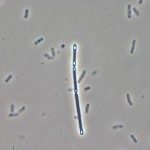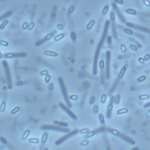Link to Pubmed [PMID] – 10844697
Mol. Microbiol. 2000 Jun;36(5):1135-47
Bacillus subtilis synthesizes polyamines by decarboxylating arginine to agmatine, which is subsequently hydrolysed to putrescine. Spermidine is synthesized from putrescine and decarboxylated S-adenosylmethionine (dAdoMet). In Gram-negative bacteria and in eukaryotes, AdoMet is decarboxylated by an unusual ‘pyruvoyl’ AdoMet decarboxylase (SpeD), the catalytic pyruvoyl moiety of which is generated by serinolysis of an internal serine with self-cleavage of the protein at the upstream peptide bond. Neither the Gram-positive bacterial nor the archaeal counterpart of the Escherichia coli SpeD enzyme were known. We have identified the corresponding B. subtilis speD gene (formely ytcF). Heterologous expression of the cognate Methanococcus jannaschii protein, MJ0315, demonstrated that it displays the same activity as B. subtilis SpeD, indicating that spermidine biosynthesis in Gram-positive bacteria and in archaea follows a pathway very similar to that of Gram-negatives and eukarya. In B. subtilis, transcription of speD is modulated by spermidine and methionine. Its expression is high under usual growth conditions. In contrast, the SpeD protein self-cleaves slowly in vitro, a noticeable difference with its archaeal counterpart. Under certain growth conditions (minimal medium containing succinate and glutamate as a carbon source), speD is co-transcribed with gapB, the gene encoding glyceraldehyde-3-phosphate dehydrogenase, an enzyme required for gluconeogenesis. This observation may couple polyamine metabolism to sulphur and carbon metabolism by a so far unknown mechanism.

